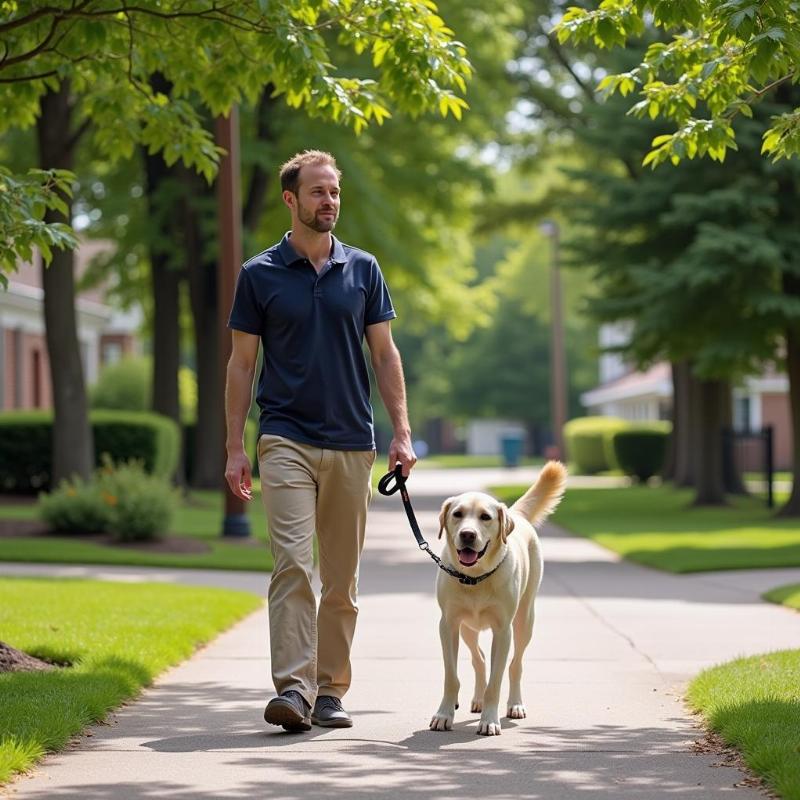The question “do male dogs prefer female owners?” often pops up in dog-loving circles. While it’s tempting to believe our furry friends have a preference for one gender over another, the reality is more nuanced. This article delves into the science behind canine behavior, debunking common misconceptions and exploring the dynamics of dog-owner relationships.
Understanding Canine Behavior and Bonding
Dogs form bonds based on consistency, positive reinforcement, and clear communication, not gender. A dog might gravitate towards a particular person due to their training methods, play style, or even the tone of their voice. Does this mean males prefer females? Not necessarily. It simply highlights that dogs are individuals with unique personalities and preferences, shaped by their experiences.
For example, a male dog might seem more attached to a female owner who provides gentle cuddles and quiet playtime. Conversely, another male dog might prefer a male owner who engages in more vigorous activities like fetch or hiking. These preferences stem from the individual dog’s temperament and the type of interaction they find rewarding, not the owner’s gender.
Debunking the “Male Dog, Female Owner” Myth
The idea that male dogs prefer female owners is largely anecdotal. While some male dogs might exhibit a stronger attachment to female figures, this is often attributed to learned behaviors and socialization rather than an inherent preference. Early experiences, particularly during puppyhood, play a crucial role in shaping a dog’s social preferences.
A male dog raised primarily by women might be more accustomed to their communication style and interaction patterns, leading to a seemingly stronger bond. However, this doesn’t imply a biological predisposition towards female owners. With proper socialization and positive interactions, male dogs can form equally strong bonds with male owners.
The Importance of Consistent Training and Socialization
Consistent training and positive reinforcement are key to building a strong bond with any dog, regardless of gender. Clear communication, consistent routines, and rewarding positive behaviors foster trust and strengthen the dog-owner relationship. Socializing your dog from a young age also plays a vital role in their development, exposing them to various people, environments, and situations, helping them become well-adjusted adults.
 Man walking his dog
Man walking his dog
Building a Strong Bond with Your Male Dog
Whether you’re a male or female owner, the principles of building a strong bond with your male dog remain the same:
- Positive reinforcement: Reward desired behaviors with treats, praise, or playtime.
- Clear communication: Use consistent commands and body language.
- Patience and understanding: Recognize that every dog is an individual and learns at their own pace.
- Quality time: Dedicate time for play, walks, and cuddles.
- Consistent routine: Provide a predictable schedule for feeding, walks, and playtime.
Conclusion
So, do male dogs prefer female owners? The evidence suggests it’s a myth. A dog’s preference for a particular person is based on individual experiences, socialization, and the quality of interaction, not gender. By focusing on consistent training, positive reinforcement, and clear communication, you can build a strong, loving bond with your male dog, regardless of your gender. Understanding your dog’s individual needs and tailoring your interactions accordingly is the key to a happy and fulfilling relationship.
FAQ
- Do male dogs behave differently with male and female owners? Not inherently. Differences in behavior are typically due to individual personalities and learned behaviors, not the owner’s gender.
- Is it harder for men to bond with male dogs? Absolutely not! With consistent training and positive reinforcement, men can build strong bonds with male dogs.
- How can I tell if my male dog is bonded with me? Signs of bonding include following you around, seeking physical contact, responding to your commands, and showing excitement when you return.
- Do neutered male dogs have different bonding patterns? Neutering can sometimes reduce certain gender-driven behaviors, but it doesn’t fundamentally change a dog’s ability to bond with their owner.
- What if my male dog seems to prefer other people? This could be due to various factors, including their individual personality, socialization, and the type of interaction they receive from others. Consistent training and positive reinforcement can help strengthen your bond.
- Are certain breeds of male dogs more likely to bond with females? No, breed doesn’t determine gender preference in bonding.
- Does a dog’s age influence their bonding preferences? A dog’s early experiences can influence their social preferences, but they can form strong bonds with new people at any age.
Related Articles on Beautdogs.us
Beautdogs.us is your premier source for all things dog-related in the US. We offer expert advice on dog breeds, care, and products, catering to both new and experienced dog owners. From rhinestone dog collars small dogs to training tips and breed-specific information, we’re your trusted companion on your dog ownership journey. Explore our comprehensive resources and discover the joy of responsible dog ownership. Contact us today for personalized support! Email: [email protected], Phone: +1 501-555-7529. Connect with Beautdogs.us today!